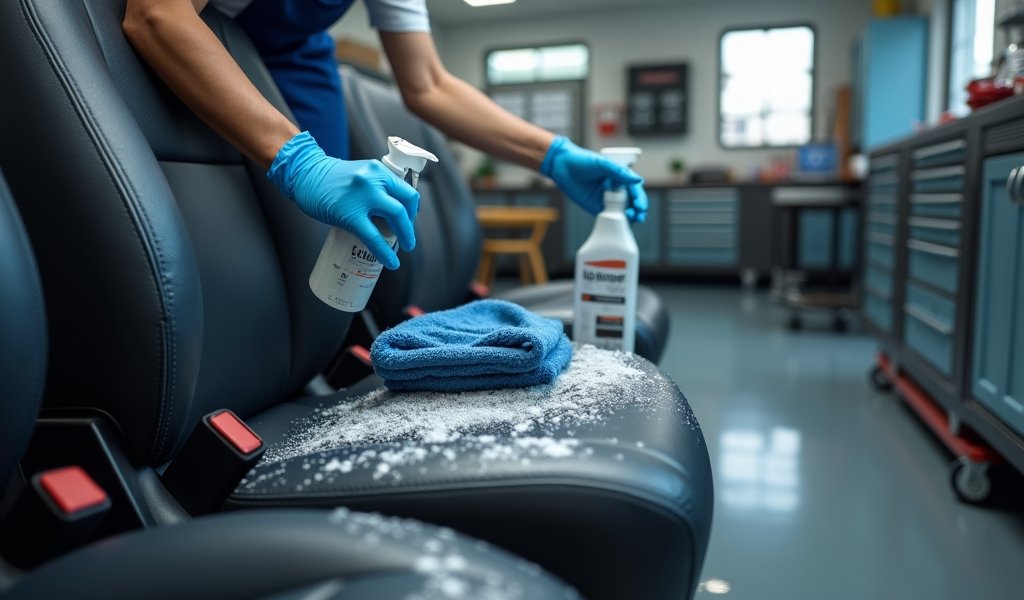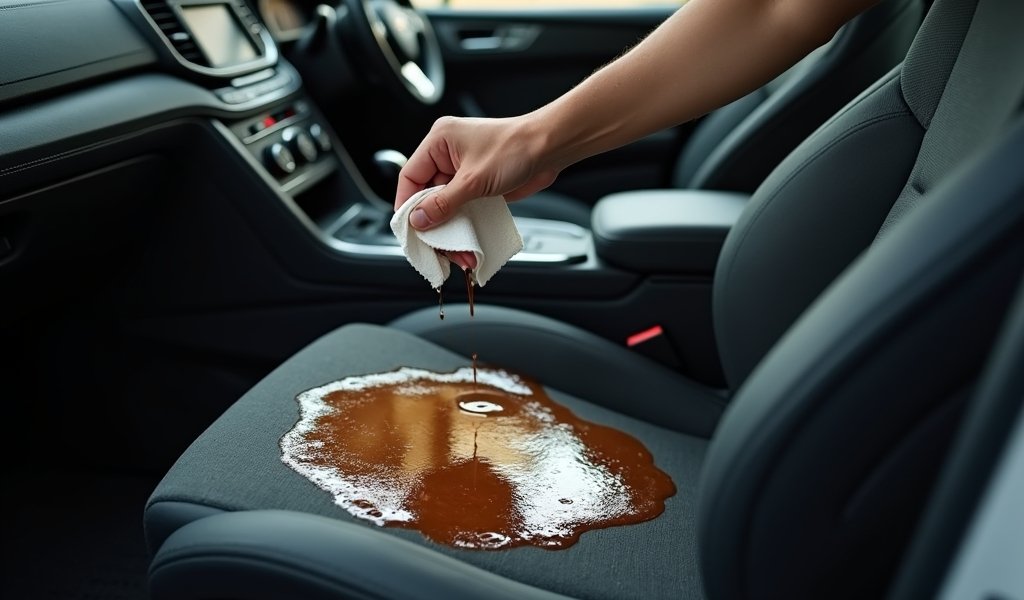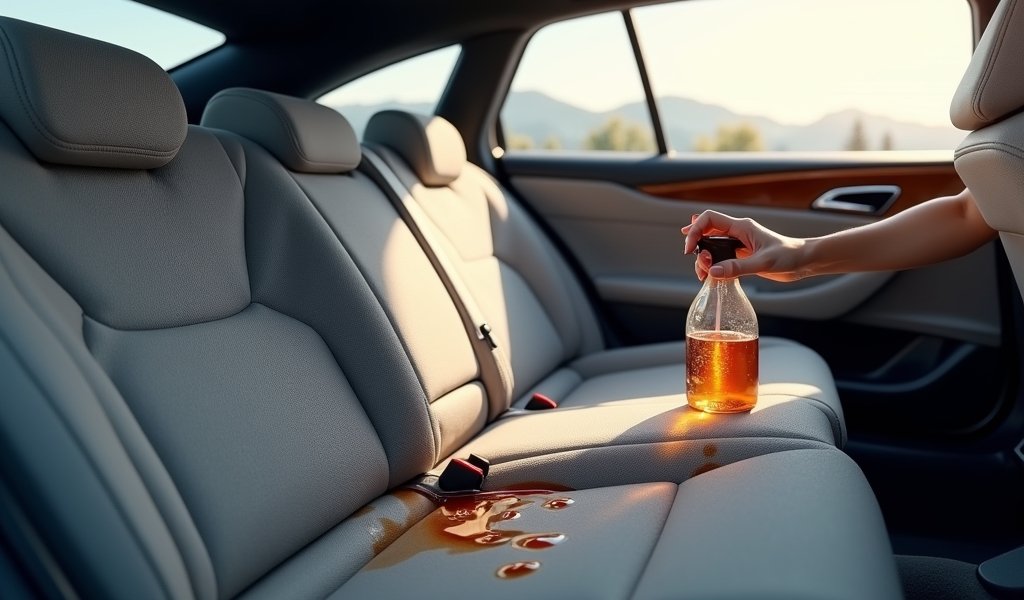Overview
This article provides five methods for removing soda stains from car seats, including immediate blotting, using club soda/vinegar solutions, dish soap method, baking soda paste for stubborn stains, and commercial cleaners, with each technique tailored to different stain scenarios and upholstery types. The guide emphasizes that acting quickly is crucial for effective stain removal, and prevention strategies like using spill-proof containers and seat protectants are the best long-term solution.
Table of Contents
- The Sticky Situation: Understanding Soda Stains
- Tip #1: Act Fast – Blotting is Your Best Friend
- Tip #2: Club Soda and Vinegar Solutions
- Tip #3: The Dish Soap Method
- Tip #4: Baking Soda Paste for Stubborn Stains
- Tip #5: When to Use Commercial Cleaners
- Prevention: The Best Solution
- Conclusion
- Frequently Asked Questions
The Sticky Situation: Understanding Soda Stains
It happens to the best of us. One moment you’re enjoying a refreshing soda on the road, and the next—splash—you’ve got a sticky mess soaking into your car seats. As an automotive technician who’s seen thousands of vehicles over the years, I can tell you that removing soda stains from car seats is one of the most common interior cleaning challenges vehicle owners face.
What makes soda stains particularly troublesome is their triple-threat nature. First, there’s the high sugar content that becomes increasingly sticky as it dries. Second, the artificial dyes in colored sodas (especially colas, grape, and orange varieties) can penetrate fabric fibers quickly. Third, the acidic nature of carbonated beverages can actually damage certain upholstery types if left untreated.
The good news? With the right approach and a bit of elbow grease, you can remove soda stains from car seats completely. In my 15+ years working with vehicle interiors, I’ve refined these five techniques that work for everything from fresh spills to those mysterious sticky spots from who-knows-when.
Tip #1: Act Fast – Blotting is Your Best Friend
When soda splashes onto your car seat, time is truly of the essence. The longer that sugary liquid sits, the harder it becomes to remove completely. But here’s what many people get wrong—they immediately start scrubbing, which actually forces the liquid deeper into the upholstery fibers.
Instead, grab clean, absorbent materials (paper towels or microfiber cloths work best) and follow this blotting technique:
- Press down firmly but don’t rub—let the absorbent material do the work
- Work from the outer edges toward the center to prevent spreading
- Replace your cloth or paper towel as it becomes saturated
- Continue until the material comes away nearly dry
For fresh spills, this simple step alone can remove up to 80% of the potential staining agents before they set. It’s particularly important for cloth seats, which have porous fibers that quickly soak up liquids.
If you’re dealing with leather seats, you have a slight advantage—the liquid will bead up longer before soaking in. Still, don’t delay; even leather’s protective coating can be compromised by acidic soda if left too long.
One critical mistake to avoid: never use hot water or heat during this initial cleaning phase. Heat can cause the sugars in soda to caramelize, making the stain nearly impossible to remove. Room temperature or cool solutions only!

Tip #2: Club Soda and Vinegar Solutions
Once you’ve blotted up as much liquid as possible, it’s time to tackle the remaining stain. In my garage, we have access to all kinds of specialized cleaners, but I’ll let you in on a secret: some of the most effective solutions for removing soda stains from car seats are probably already in your kitchen.
The club soda method works surprisingly well, especially on fresh stains. The carbonation helps lift the stain while its mild nature won’t damage your upholstery. Simply:
- Pour a small amount of plain club soda onto a clean cloth (never directly onto the seat)
- Dab gently at the stain, rotating to a clean section of cloth frequently
- Blot with a dry cloth to remove excess moisture
For a more powerful solution, white vinegar is my go-to remedy. Don’t worry about the smell—it dissipates completely as it dries. Mix equal parts white vinegar and cool water in a spray bottle, then:
- Lightly mist the affected area (don’t soak it)
- Let the solution sit for 2-3 minutes to break down the sugars
- Blot with a clean, dry cloth using gentle pressure
- Repeat if necessary for stubborn stains
According to research from the American Chemical Society, acidic solutions like vinegar are particularly effective at breaking down the molecular bonds in sugar-based stains, which is why this method works so well for soda.
This approach is gentle enough for most car upholstery types, but if you have premium leather or specialized fabric, test in an inconspicuous area first. I’ve used this method on everything from basic cloth to higher-end vehicles with great results.
Tip #3: The Dish Soap Method
When club soda or vinegar aren’t cutting it, it’s time to step up to a mild dish soap solution. Dish soap is specifically formulated to break down grease and sugars—exactly what makes soda stains so stubborn. I’ve found this method particularly effective for day-old stains that have had some time to set but aren’t completely dry yet.
Here’s my tried-and-true approach:
- Mix 1 tablespoon of mild dish soap (nothing harsh or heavily scented) with 2 cups of cool water
- Stir gently until slightly sudsy but not overly foamy
- Dampen a clean microfiber cloth with the solution (the cloth should be wet but not dripping)
- Working in small sections, gently dab and lift the stain—avoid harsh scrubbing
The key that many people miss is the rinsing step. After treating with soap, you absolutely must remove all soap residue or you’ll end up with a dirt-attracting surface. For proper rinsing:
- Prepare a second cloth with clean water
- Blot the treated area thoroughly to remove soap
- Follow with a dry cloth to remove excess moisture
This method works well on both cloth and vinyl surfaces. For removing stubborn car seat stains like soda, the key is patience and gentle pressure rather than aggressive scrubbing, which can damage fabric fibers or leather finishes.
One professional tip I share with all my customers: always work in good lighting so you can see the stain’s edges clearly. What looks clean in dim garage lighting might still show spots once you’re in bright sunlight.
Tip #4: Baking Soda Paste for Stubborn Stains
When you’re dealing with soda stains that have had time to fully dry and set into your car seats, it’s time to bring out one of the most versatile cleaning agents in your pantry: baking soda. This mild abrasive works by both lifting stains and neutralizing odors—a perfect combination for old soda spills.
I’ve rescued countless “hopeless” car interiors with this method:
- Mix 3 parts baking soda with 1 part water to create a thick paste
- Apply directly to the stained area using a soft cloth or even your fingers
- Work the paste gently into the stain using circular motions
- Allow to dry completely (usually 2-4 hours depending on humidity)
- Vacuum thoroughly using an upholstery attachment
The beauty of this method is that as the paste dries, it pulls the stain particles up and out of the fabric. You’ll actually see the baking soda change color as it absorbs the stain—that’s how you know it’s working.
For particularly stubborn stains, I sometimes recommend creating a “moisture barrier” to extend the baking soda’s effectiveness. After applying the paste:
- Cover the treated area with plastic wrap
- Place a heavy book on top to create gentle, consistent pressure
- Let sit overnight for maximum absorption
This technique is especially effective on porous cloth seats where the soda has penetrated deeply. It’s generally safe for most upholstery types, though I always recommend testing in an inconspicuous spot first, particularly for delicate fabrics or specialized automotive textiles.
After vacuuming, if you notice any baking soda residue, a lightly dampened microfiber cloth will remove it. Just be careful not to re-wet the area excessively, as this can reactivate any remaining stain particles.

Tip #5: When to Use Commercial Cleaners
Sometimes, despite your best DIY efforts, a particularly stubborn soda stain requires commercial cleaning products. In my professional experience, there are specific situations when reaching for these products makes sense—and choosing the right one for your specific upholstery is crucial.
First, let’s match the cleaner to your seat material:
- For cloth seats: Look for fabric-specific upholstery cleaners that specify “safe for automotive use”
- For leather seats: Only use pH-balanced leather cleaners followed by a leather conditioner
- For vinyl or leatherette: Choose cleaners specifically formulated for synthetic materials
When selecting a commercial product, I always advise my clients to check if it’s endorsed by automotive industry associations or major car manufacturers. These endorsements typically indicate products that clean effectively without damaging automotive materials.
Before applying any commercial cleaner to your soda stain:
- Test in an inconspicuous area (under the seat or in a corner)
- Wait 24 hours to ensure no discoloration or damage occurs
- Read and follow all manufacturer instructions precisely
- Use only the recommended amount—more isn’t better
For particularly valuable vehicles or extensive staining, consider professional detailing services. While I’m a big advocate for DIY solutions, sometimes the specialized equipment and industrial-strength (yet safe) products professionals use can tackle stains that home methods can’t quite eliminate.
Having an emergency car spill cleanup kit that includes the right commercial cleaner for your specific upholstery can save you significant time and frustration when accidents happen.
Prevention: The Best Solution
As someone who’s spent years cleaning car interiors, I can tell you with absolute certainty: preventing soda stains is infinitely easier than removing them. A few simple habits and investments can save you hours of cleaning frustration down the road.
Consider these practical prevention strategies:
- Invest in quality spill-proof travel mugs with secure lids
- Use aftermarket cup holder inserts with better stabilization
- Apply fabric protectant sprays designed specifically for automotive upholstery
- Keep a small “quick-response” cleaning kit in your glove compartment
- Consider seat covers for vehicles frequently used by children or during road trips
One of the best preventative investments you can make is a quality car upholstery cleaner for spills that’s specifically designed to be gentle on your car’s interior materials. Keep this with some microfiber cloths in your trunk for immediate response to accidents.
For those with children (or particularly clumsy adults), waterproof seat covers can be a lifesaver. The technology has improved dramatically in recent years—today’s options are far more comfortable and attractive than the plastic-feeling covers of the past.
If you’re particularly serious about prevention, consider having your seats professionally treated with a hydrophobic coating. These treatments create an invisible barrier that repels liquids, giving you valuable extra seconds to blot spills before they penetrate fabrics.
Conclusion
Removing soda stains from car seats doesn’t have to be a losing battle. With the five effective methods we’ve covered—from immediate blotting to specialized commercial cleaners—you now have a complete arsenal to tackle everything from fresh spills to set-in stains that have been lurking for weeks.
Remember that the key to successful stain removal is matching the right technique to both the age of the stain and your specific upholstery type. Start with the gentlest method appropriate for your situation and work your way up as needed.
In my years working with vehicle interiors, I’ve seen these methods transform seemingly ruined upholstery back to near-showroom condition. The most important factors are acting quickly, being thorough, and having patience with the process.
Whether you’re dealing with a fresh spill or discovering an old sticky spot, these professional techniques will help restore your car’s interior and preserve both its appearance and value. After all, the average American spends nearly 300 hours per year in their vehicle—it deserves to be a clean, comfortable space you can enjoy.
Frequently Asked Questions
Can dried soda stains be removed from car seats?
Yes, dried soda stains can be removed using a baking soda paste or commercial upholstery cleaner. The key is patience and possibly multiple applications for older, set-in stains.
Will soda damage leather car seats?
Yes, the acidic nature of soda can damage leather by breaking down its protective coating if left untreated. Clean spills immediately and follow with a leather conditioner to protect the material.
How do I remove soda smell from my car interior?
Use a vinegar solution (equal parts water and white vinegar) followed by baking soda to neutralize odors. Allow proper ventilation after cleaning to eliminate any remaining smells.
Can I use hydrogen peroxide to remove soda stains?
Hydrogen peroxide can be effective on light-colored upholstery but may cause discoloration on darker fabrics. Always test in an inconspicuous area first and use a 3% solution diluted with equal parts water.
How often should I clean my car seats to prevent stain buildup?
Clean your car seats thoroughly every 3-4 months for regular maintenance, and address spills immediately as they occur. Regular cleaning prevents stain buildup and extends the life of your upholstery.

